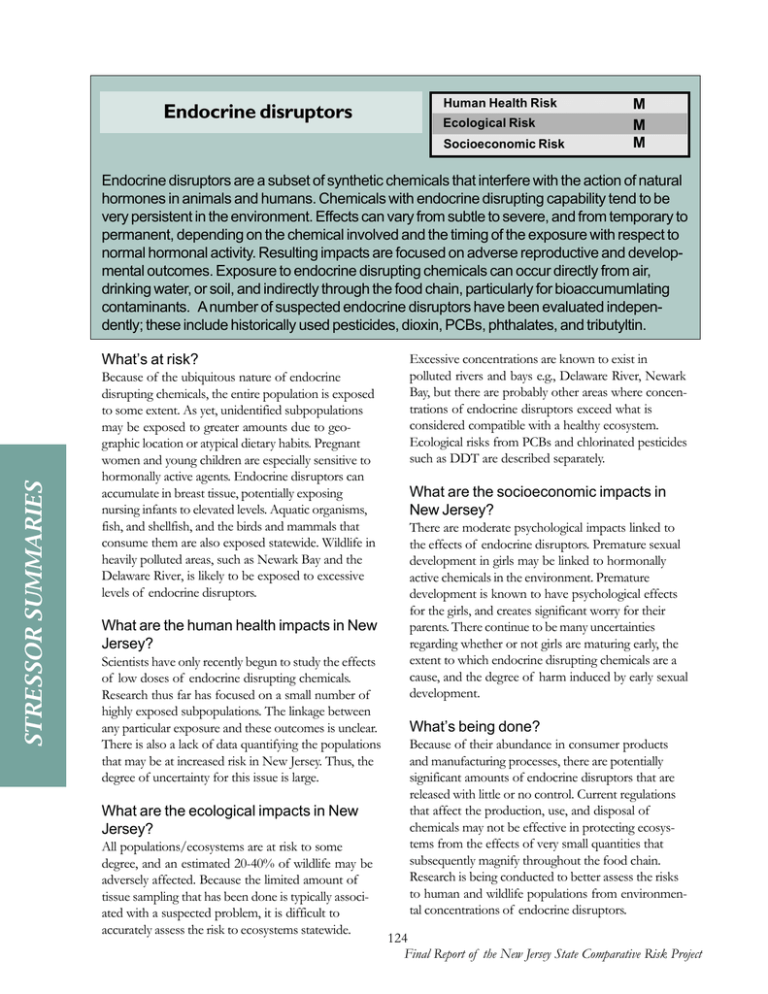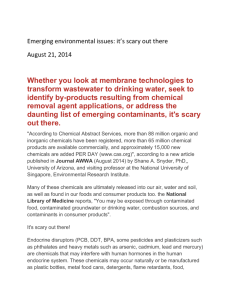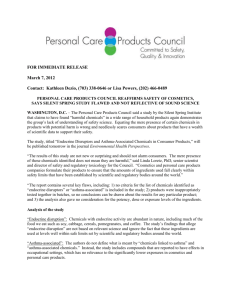
Endocrine disruptors
Human Health Risk
Ecological Risk
Socioeconomic Risk
M
M
M
Endocrine disruptors are a subset of synthetic chemicals that interfere with the action of natural
hormones in animals and humans. Chemicals with endocrine disrupting capability tend to be
very persistent in the environment. Effects can vary from subtle to severe, and from temporary to
permanent, depending on the chemical involved and the timing of the exposure with respect to
normal hormonal activity. Resulting impacts are focused on adverse reproductive and developmental outcomes. Exposure to endocrine disrupting chemicals can occur directly from air,
drinking water, or soil, and indirectly through the food chain, particularly for bioaccumumlating
contaminants. A number of suspected endocrine disruptors have been evaluated independently; these include historically used pesticides, dioxin, PCBs, phthalates, and tributyltin.
STRESSOR SUMMARIES
What’s at risk?
Because of the ubiquitous nature of endocrine
disrupting chemicals, the entire population is exposed
to some extent. As yet, unidentified subpopulations
may be exposed to greater amounts due to geographic location or atypical dietary habits. Pregnant
women and young children are especially sensitive to
hormonally active agents. Endocrine disruptors can
accumulate in breast tissue, potentially exposing
nursing infants to elevated levels. Aquatic organisms,
fish, and shellfish, and the birds and mammals that
consume them are also exposed statewide. Wildlife in
heavily polluted areas, such as Newark Bay and the
Delaware River, is likely to be exposed to excessive
levels of endocrine disruptors.
What are the human health impacts in New
Jersey?
Scientists have only recently begun to study the effects
of low doses of endocrine disrupting chemicals.
Research thus far has focused on a small number of
highly exposed subpopulations. The linkage between
any particular exposure and these outcomes is unclear.
There is also a lack of data quantifying the populations
that may be at increased risk in New Jersey. Thus, the
degree of uncertainty for this issue is large.
What are the ecological impacts in New
Jersey?
All populations/ecosystems are at risk to some
degree, and an estimated 20-40% of wildlife may be
adversely affected. Because the limited amount of
tissue sampling that has been done is typically associated with a suspected problem, it is difficult to
accurately assess the risk to ecosystems statewide.
Excessive concentrations are known to exist in
polluted rivers and bays e.g., Delaware River, Newark
Bay, but there are probably other areas where concentrations of endocrine disruptors exceed what is
considered compatible with a healthy ecosystem.
Ecological risks from PCBs and chlorinated pesticides
such as DDT are described separately.
What are the socioeconomic impacts in
New Jersey?
There are moderate psychological impacts linked to
the effects of endocrine disruptors. Premature sexual
development in girls may be linked to hormonally
active chemicals in the environment. Premature
development is known to have psychological effects
for the girls, and creates significant worry for their
parents. There continue to be many uncertainties
regarding whether or not girls are maturing early, the
extent to which endocrine disrupting chemicals are a
cause, and the degree of harm induced by early sexual
development.
What’s being done?
Because of their abundance in consumer products
and manufacturing processes, there are potentially
significant amounts of endocrine disruptors that are
released with little or no control. Current regulations
that affect the production, use, and disposal of
chemicals may not be effective in protecting ecosystems from the effects of very small quantities that
subsequently magnify throughout the food chain.
Research is being conducted to better assess the risks
to human and wildlife populations from environmental concentrations of endocrine disruptors.
124
Final Report of the New Jersey State Comparative Risk Project








